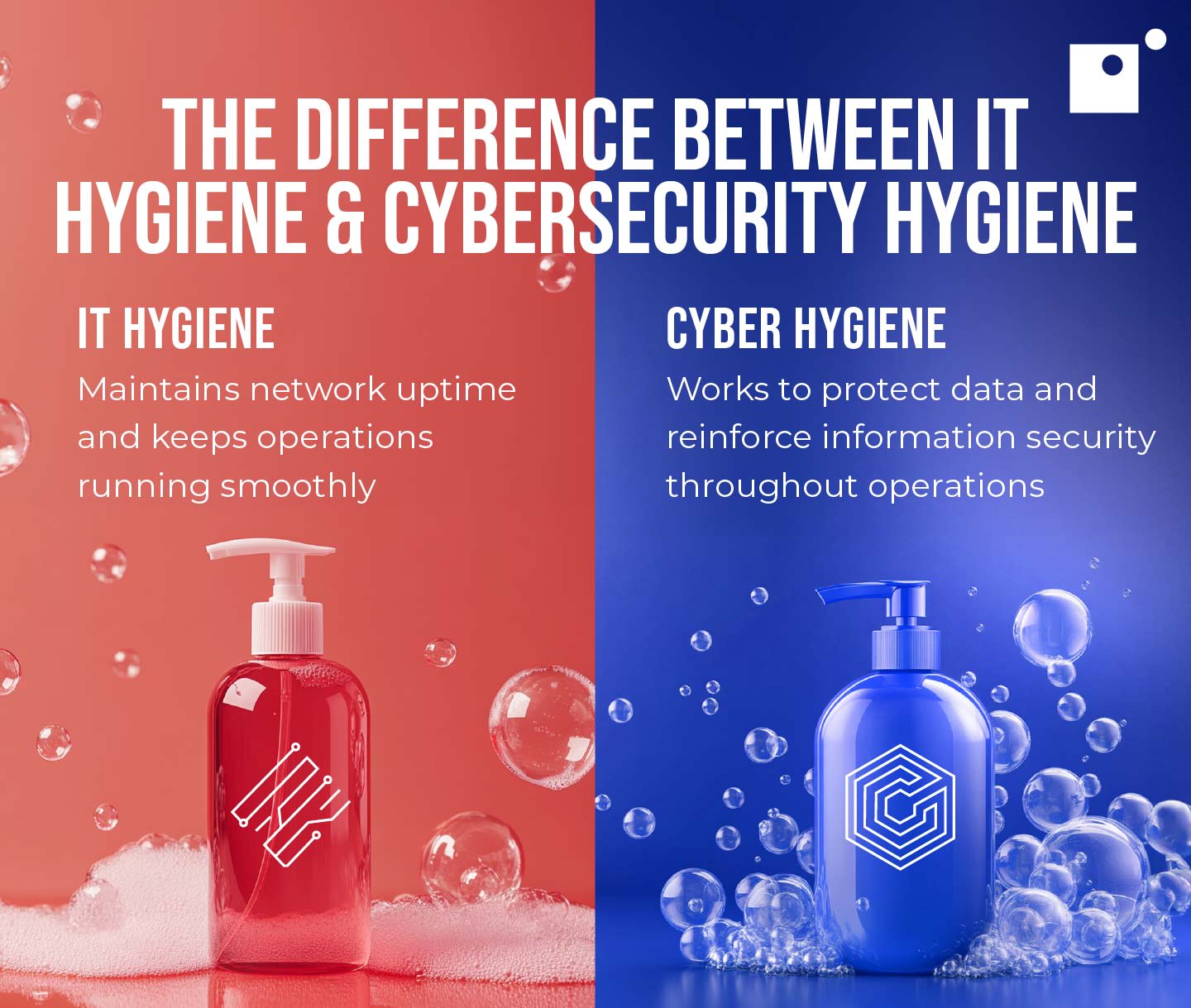An unkept IT environment can lead to network failure, data breaches, and costly downtime. Your organization can avoid this by implementing IT hygiene practices that keep your network healthy, and operations running smoothly.
IT hygiene can help a business minimize the risk of cyberattacks and avoid data breaches. It also helps ensure that your systems are always running so that you can serve your customers uninterrupted.
In short, IT hygiene refers to the regular maintenance and monitoring of IT systems to ensure security, reliability, and optimal performance. It includes updating software, managing patches, backing up data, and implementing security measures like antivirus protection.
Join us below to learn more about IT hygiene practices, how to implement them, and how they compare to elements of cyber hygiene!
For more information on modern IT solutions that organizations rely on today, check out Impact’s webinar, Why the IT Break/Fix Model is Broken!
What Is IT Hygiene?
As mentioned above, IT hygiene is a set of practices that businesses and employees can adopt to maintain a healthy network and strong IT environment. As such, practicing IT hygiene is one aspect of information security, which focuses on data confidentiality, integrity, and availability.
Identify Your Assets
To maintain good IT hygiene, organizations should take stock of their important assets, both physical and digital. By identifying which data, devices, and tools to focus on, your organization can make the best of its IT resources without wasting technology or energy on less important assets.
Cataloguing your assets will also help prevent important data decay, cloud sprawl—when a company loses track of its cloud solutions and cloud databases proliferate—as well as software sprawl. This can cause data and department silos, slow down operations, and create confusion if many versions of the same data sets exist.
In turn, this will mean a well-managed budget since your company won’t have to invest in unused software programs, data recovery efforts, or surprise IT incidents.
Once you have identified your assets, you can start practicing IT hygiene regularly and reap the benefits of a healthy network.
IT Hygiene Tips
The following recommendations can help you organize your data so it’s readily available, allowing your business to make the most out of their collected data and comprehensive tech stack:
- Schedule computer software updates and patches at least once per month; cybercrime evolves daily. Bad actors continuously get better at their craft, which means leaving any software unpatched and outdated increases the number of known vulnerabilities in your environment.
- Defragment your computer at least once a month: Defragmenting helps optimize your hard drive and ensure it works properly.
- Clean your hardware often to prevent damage and overheating.
How Regular IT Hygiene Supports Business Growth at Scale
As businesses scale, their IT environments become increasingly complex, with more systems, users, and data flowing through the organization. Without consistent IT hygiene, this complexity can quickly lead to inefficiencies, vulnerabilities, and service disruptions that stall growth.
A well-maintained IT infrastructure is foundational to operational stability. It ensures that internal workflows run smoothly, platforms remain accessible, and teams can collaborate without friction.
This reliability also directly impacts how services are delivered to clients and customers. When systems are responsive and secure, service delivery becomes seamless and customer interactions feel effortless. That kind of consistency builds trust and reinforces a company’s reputation for professionalism and dependability.
Practicing regular IT hygiene offers a range of tangible benefits that support both day-to-day operations and long-term scalability:
- Minimized downtime, reducing the risk of service interruptions that frustrate users and impact revenue
- Improved system performance, allowing teams to work faster and more efficiently
- Enhanced security posture, protecting sensitive data and reducing exposure to cyber threats
- Greater agility, enabling quicker adoption of new technologies and smoother onboarding of new users
- Stronger compliance, helping meet regulatory requirements with up-to-date systems and documentation
- Scalable infrastructure, making it easier to expand services and enter new markets without major overhauls
From a growth perspective, IT hygiene enables scalability. Clean, well-documented systems are easier to expand, integrate, and adapt. Whether onboarding new employees, launching new services, or entering new markets, a stable IT foundation allows businesses to move quickly and confidently.
This also supports innovation—teams can experiment with new tools and technologies without fear of destabilizing core operations.
Ultimately, regular IT hygiene isn’t just about keeping systems tidy; it’s about creating a resilient, agile infrastructure that supports long-term growth. It empowers businesses to deliver consistent value, respond to evolving customer needs, and scale without compromising quality or security.
Cyber Hygiene Vs. IT Hygiene
IT hygiene and cyber hygiene are closely related concepts, but they focus on different aspects of maintaining a secure and efficient digital environment. IT hygiene broadly refers to the overall management and upkeep of an organization's IT systems, including hardware, software, and networks. It encompasses activities like system updates and patches, data backups, and hardware maintenance.
The primary goal of IT hygiene is to ensure that all components of the IT infrastructure function smoothly, minimize downtime, and reduce the risk of technical issues that could disrupt business operations.
Cyber hygiene, on the other hand, is more specifically focused on the practices and measures that protect an organization’s digital assets from cyber threats. It involves the proactive management of security protocols, such as enforcing strong passwords, regularly updating software to address vulnerabilities, implementing firewalls, and conducting regular security audits.
Cyber hygiene also includes user education to prevent behaviors that could expose the organization to risks, such as falling for phishing attacks or using unsecured networks. While IT hygiene covers a broader scope of IT management, cyber hygiene zeroes in on the security aspect, ensuring that the organization’s data, systems, and networks are protected against malicious activities.
In summary, IT hygiene is about the general health and efficiency of IT systems, whereas cyber hygiene focuses specifically on safeguarding these systems from cyber threats. Both are essential for maintaining a robust and secure IT environment, but they address different layers of an organization’s digital infrastructure.
Cyber Hygiene Tips
To increase the efficacy and strength of your cybersecurity strategy within your organization, consider the following recommendations that can improve employee cyber hygiene as well:
- Establish a protocol for employees to use strong passwords, change their passwords often, and use multi-factor authentication.
- Clear cookies from your browser at least once a month. It will protect your privacy and prevent browser performance problems.
- Provide cybersecurity training for your workforce so they understand current security practices such as phishing and social engineering awareness.
- Perform a cybersecurity audit so you can find and patch any vulnerabilities.
- Leverage technology such as network monitoring, next-gen antivirus, endpoint protection, etc.
- Follow compliance regulations and laws to prevent data leaks and preserve customer trust.
Implementing IT Hygiene Practices
Implementing IT hygiene practices in an organization begins with training employees and establishing a comprehensive maintenance and monitoring plan. This plan should include regular updates and patch management for all software and systems to ensure they are protected against known vulnerabilities.
Organizations should schedule routine checks for hardware to prevent failures and ensure that backups are performed regularly, with data stored securely offsite or in the cloud. Additionally, implementing a centralized management system can help streamline the monitoring and updating processes, allowing IT teams to quickly identify and address issues across the network.
Establishing clear IT policies and enforcing them consistently helps create a culture of accountability, where employees understand their role in maintaining IT hygiene. Regular audits and assessments can further ensure that IT hygiene practices are being followed effectively, allowing organizations to identify areas for improvement and adapt to emerging threats.
Additionally, modern organizations benefit from having a clearly documented set of policies when it comes to IT and cybersecurity behaviors.
By integrating these practices into daily operations, an organization can maintain a secure, efficient, and resilient IT environment.
Wrapping Up on Practicing IT Hygiene
Businesses are relying on more and more technology each and every year, meaning that IT environments are becoming more and more complicated every year as well. In turn, IT hygiene has become a focal point in maintaining organizational operations.
By practicing IT hygiene throughout your organization, you can benefit from confidential, high-quality, and well-organized data, that’s readily available to those who need it. All-in-all, IT hygiene is an essential aspect of developing an IT environment that functions properly, experiences minimal downtime, and allows you to focus on the core of the business.
Get more information on moder IT strategies in Impact’s webinar, Why the IT Break/Fix Model is Broken!





